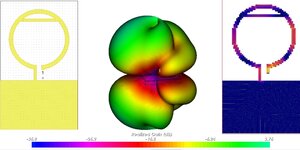doenisz
Junior Member level 2
Hi everyone,
I am trying to measure the impedance of my circular loop antenna at 3.5GHz. It is heavily inductive, with my HFSS simulations giving its impedance as around 6+j280 at 3.5GHz.
Here is how it looks like, there is soldermask exclude around it:

There is no ground plane on this PCB, as it kills the radiation of this antenna. It is on FR4 substrate, which, I know is lossy, but this is just a prototype, I will pass to low-loss RF substrates (like Rogers) in the actual implementation.
My question is that, I have just measured the S-parameters of this with a network analyzer that has a probe station. Its probes are -unlike my antenna- signal and ground and not differential. I just physically touch the signal probe to one terminal and ground to other.
Basically, I observed very similar reactance to my simulations, but the resistance (real part) turned out to be 70 ohms, which is SEVERELY off from the simulations.
Is there anything wrong with my approach? I asked this question on Reddit too, and someone recommended using a Balun to convert from single-ended to differential signaling. He also mentioned "chassis" which I have no idea about? ( )
In the HFSS simulations, I just use a lumped-port, I have no idea if it is differential or single-ended, nor if it's the cause of my problems for the huge resistance discrepancy.
How should I go about taking more accurate measurements?
Thanks for any help.
I am trying to measure the impedance of my circular loop antenna at 3.5GHz. It is heavily inductive, with my HFSS simulations giving its impedance as around 6+j280 at 3.5GHz.
Here is how it looks like, there is soldermask exclude around it:
There is no ground plane on this PCB, as it kills the radiation of this antenna. It is on FR4 substrate, which, I know is lossy, but this is just a prototype, I will pass to low-loss RF substrates (like Rogers) in the actual implementation.
My question is that, I have just measured the S-parameters of this with a network analyzer that has a probe station. Its probes are -unlike my antenna- signal and ground and not differential. I just physically touch the signal probe to one terminal and ground to other.
Basically, I observed very similar reactance to my simulations, but the resistance (real part) turned out to be 70 ohms, which is SEVERELY off from the simulations.
Is there anything wrong with my approach? I asked this question on Reddit too, and someone recommended using a Balun to convert from single-ended to differential signaling. He also mentioned "chassis" which I have no idea about? ( )
In the HFSS simulations, I just use a lumped-port, I have no idea if it is differential or single-ended, nor if it's the cause of my problems for the huge resistance discrepancy.
How should I go about taking more accurate measurements?
Thanks for any help.
